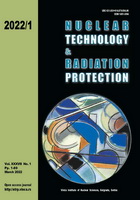
ESTIMATION OF LIQUID DENSITY USING ARTIFICIAL NEURAL NETWORK IN GAMMA-RAY SCATTERING MEASUREMENT
Pages: 31-41
Authors: Hoang D. Tam, Truong T. Sang, Nguyen T. K. Anh, Tran N. M. Trung, Vu N. Quang, Nguyen T. Dat, Lam D. Nhat, and Huynh D. ChuongAbstract
The feasibility of an artificial neural network for the estimation of the liquid density, in gamma scattering measurement, has been investigated in this paper. The liquid density was estimated using a well-trained artificial neural network model with only two input parameters: the scattering angle and the ratio of the area under a single scattering peak for a liquid relative to that for water. It is worth noting that the whole training data was generated by carrying out the Monte Carlo simulation using Monte Carlo N-Particle code. The results indicated that the artificial neural network model exhibits a good correlation between the estimated and reference densities, at all the investigated scattering angles, with a relative error below 5.5 %. Next, the trained model is used to predict the liquid density with the input data of being the experimatal data, which yield the relative deviation between the predicted density and the reference one, mostly less than 5 % (only three cases with deviation in the range from 5-8.1 %). The obtained results demonstrated that the model developed in this work gives more accurate results within the defined conditions.
Key words: gamma scattering, liquid density, NaI(Tl), artificial neural network
FULL PAPER IN PDF FORMAT (1.27 MB)
